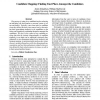Free Online Productivity Tools
i2Speak
i2Symbol
i2OCR
iTex2Img
iWeb2Print
iWeb2Shot
i2Type
iPdf2Split
iPdf2Merge
i2Bopomofo
i2Arabic
i2Style
i2Image
i2PDF
iLatex2Rtf
Sci2ools
IV
2008
IEEE
2008
IEEE
Candidate Mapping: Finding Your Place Amongst the Candidates
The process ofvoting for a candidate involves selecting an individual who best matches a personal system of values and beliefs. Typically, voters must select a candidate whom they believe fits their issue stances best by determining their approximate similarity to the candidates on the issues, and cognitively positioning themselves amongst the candidates. We show in the context of our candidate position data that the intrinsic dimensionality of candidate similarity in our data can be sufficiently expressed algorithmically in two dimensions using Gower similarity and Sammon mapping. A participant study analyzes how voters choose to position themselves on this low dimensional representation, and how this positioning is related to the position dictated by their actual responses to issues, as well as to their general political stance. Keywords-Political, Visualization, Map
Approximate Similarity | Candidate Position Data | Candidate Similarity | Information Technology | IV 2008 |
| Added | 31 May 2010 |
| Updated | 31 May 2010 |
| Type | Conference |
| Year | 2008 |
| Where | IV |
| Authors | Justin Donaldson, William R. Hazlewood |
Comments (0)

